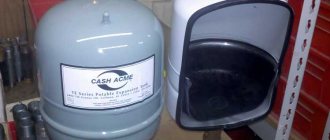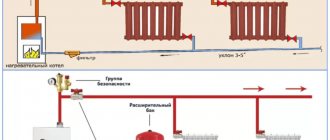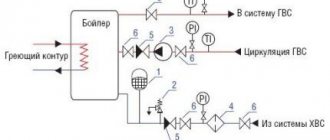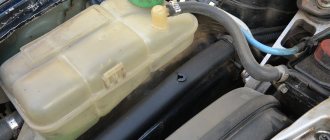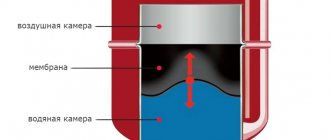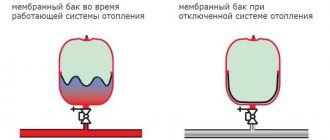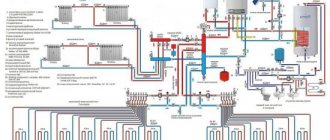- Compensation for thermal expansion of the coolant. For every 100 °C increase in temperature, the volume of water in the system increases by 4.33%. The pressure in the system circuit increases and acts on the inner surface of pipes and equipment. To prevent destruction of the heating system, an expansion tank is installed on the boiler return, it is filled with “excess” coolant;
- Due to the operation of the expansion tank, water hammer in the heating system, which occurs due to air locks or sudden shutdown of the fittings, is suppressed. To prevent water hammer from damaging the boiler, the tank is placed on the return line, in front of the heat generator.
There are two types of hydraulic tanks on sale - balloon and membrane (diaphragm) types. The former are more often used for cold water supply and are painted blue, the latter are red and are used in heating systems.
Setting indicators in the new expansion tank before starting the system
The diaphragm type tank is divided by a membrane.
One of the halves is under pressure, air or nitrogen is pumped into it. You can clarify this parameter by looking at the documents for the tank. Preliminary (factory) pressure will not necessarily be optimal for circuit operation. This setting can be easily reconfigured. Manufacturers have provided for this by leaving a spool in the body of its “air” part, with which you can regulate the air pressure. It is worth considering that all pressure gauges only show excess pressure. That is, if you need to use the concept of absolute pressure in calculations, then you always need to add one atmosphere (bar) to the pressure gauge readings.
The initial pressure in the expansion tank is set 0.2 atm higher than the coolant pressure in the cold system, which is equal to the static pressure of the circuit. This pressure is determined as the height distance between the top point of the circuit and the middle of the expansion tank. For example, if the height of the heating system is 8 m (2 floors), then the statistical pressure will be equal to:
∆P = 0.8 atm (10 m = 1 atm), then the pressure in the membrane tank is calculated as follows:
∆P + 0.2 = 0.8 + 0.2 = 1.0 atm (bar).
Below are the consequences of incorrectly set pressure:
- The tank is pumped. For example, the air cavity is initially set to 3 bar with a static pressure of 1.5 bar. When the pump starts, the coolant pressure will change, but not much - within 1 atm. It turns out that when the pressure gauge at the boiler shows a maximum of 2.5 bar, there is still 3 bar in the air part of the membrane tank. This setting negates the entire compensating ability of the membrane device - the air will tend to push the coolant out of the tank.
- The readings inside the expansion tank are underestimated. In this case, when filling a closed system, water or antifreeze will easily push through the membrane and fill the entire container. With each increase in temperature, and with it the pressure, the safety valve will operate. In this case, the hydraulic expansion tank also becomes useless.
Advice! The initial air pressure was set correctly, but the safety valves of the heating system continue to operate. The expansion tank volume may have been selected too small. To avoid this, it is recommended to install a tank whose volume is at least 10% of the total coolant volume.
Conclusions and useful video on the topic
You can learn how to independently calculate the volume of the hydraulic tank and adjust its pressure by watching the videos below.
An easy way to determine the volume of the expansion tank:
Instructions for self-adjusting the pressure level in the expansion tank:
Gas boilers must be equipped with expansion tanks. They “absorb” excess coolant resulting from heating and prevent the formation of air pockets. In double-circuit types of equipment, such devices are installed, but often their volume is insufficient for trouble-free operation of the heating.
Compensation tanks should be selected based on the pressure and volume of coolant in the system. It is important to configure the tank correctly, otherwise it will not be able to ensure uninterrupted and stable operation of the gas boiler.
Do you still have questions about pumping and adjusting the pressure in the expansion tank? Ask it in the comments block - our experts and other site visitors will try to help you.
How to measure and adjust the pressure in the expansion tank
The pressure in the heating system is controlled by pressure gauges, but the tank itself does not have a fitting for installing this device. However, there is a nipple in which a spool is mounted for pumping or releasing air. It is located on the side opposite the coolant supply. The nipple, in fact, is an analogue of a car pump, so to check this parameter or adjust it, you can use an ordinary car pump with a built-in pressure gauge.
Looking for a leak
Loss of the sealed state of the heating system leads to a loss of pressure. By conducting a complete inspection of the heating device and pipe system, leaks can be detected. Leaks to the naked eye are determined by the accumulation of moisture at joints or holes with a characteristic white coating.
When inspecting, you should pay attention to the connecting elements, couplings at soldering points and direct connections to heating devices. A system with metal pipes may leak at longitudinal seams. Once a leak is discovered, it is worth taking care of its elimination. The joints are repacked, gaskets and gland seals are installed, with a thickness slightly greater than the previous one. If the pipeline is damaged, the damaged section must be replaced.
What air pressure should be in the expansion tank of the heating system?
Indicator of the empty capacity of the air chamber at room temperature. It should be equal to the static value in a tank filled with water. In this position, the membrane is in equilibrium, and the gas pressure is compensated by the liquid pressure. For every 10 meters of pressure, about 1 atm is required. Despite this, for normal operation of the entire system it is enough to create the indicator specified in the device passport.
Photo 1. Diagram of the expansion tank for closed-type heating systems. Arrows indicate parts of the product.
, 0.9 atm is enough for favorable operation This is due to the pressure that the membrane creates during operation. Its average is 1.2 atm . Both values fluctuate within a small range with a maximum deviation of 0.1.
If the heating system is not made according to classical schemes, separate calculations are carried out for it: the volume of the coolant, the tank, the efficiency factor and the initial charging pressure are determined. To do this, you should invite a specialist who will take into account other minor factors.
How to check the indicators
The easiest way to take a measurement is to attach a pressure gauge . The problem arises during the preparation phase as most tanks do not have space for mounting. At the same time, the device must have a nipple to which a compressor with a sensor can be easily connected.
Reference. It is easy to convert the dimension of the values: 1 Bar = 1 atm = 0.1 MPa.
How to adjust the hot water pressure in the system
Water pressure is a fairly easy to adjust parameter. For this you will need:
- Make a calculation. Having completed it, 0.2 atm is subtracted from the obtained value.
- Before starting installation, bleed (or pump) air from the system to the required level.
- Connect the container to the pipeline and fill it with liquid. The process is done slowly so as not to miss the moment of establishing normal pressure.
- Connect the pump and pump in liquid until operating pressure is achieved.
- The first switching on of the device occurs after maximum water heating . In this case, the volume of liquid will increase to a value that takes into account the specific increment.
Purpose of an additional tank of a double-circuit boiler
As a rule, built-in compensation tanks in gas boilers have a volume of about 6-8 liters. They are designed to compensate for the expansion of 120 liters of coolant circulating in the heating system. Under normal operating conditions, such an expansion tank is enough for a small apartment or house.
If the heating area is large, heated floors are installed or there are many radiators in the rooms, the volume of the standard built-in tank will be small, since more water is used.
When heated, excess coolant completely fills the tank. And since there is no free space left in the tank, the water pressure increases in the heating system itself and an emergency release occurs by the safety valve. After this, it is unlikely that the gas boiler will be able to start working automatically.
To avoid such negative consequences, an additional expansion tank with a membrane is installed in the heating system in a design for a double-circuit gas boiler. When the standard tank is completely filled, the water goes into the reserve hydraulic tank. After cooling, the liquid returns to the radiators.
Setting indicators in a new membrane-type expansion tank
The device is divided into two parts, separated by a membrane. It exerts pressure on one of the halves , this is taken into account when setting up.
Most devices have factory default values, which are not always suitable for use in certain conditions.
To change the indicators, there is a nipple to which the plumber connects a compressor or hand pump.
Attention! Many pressure gauges show excess. To determine the actual pressure, add 1 atm.
The initial indicator is made equal to that obtained in the cold system by adding 0.2 atm. The sum gives the value of the static head divided by 10 . For example, in a house 8 m high:
P = 8/10 + 0.2 atm.
The values are achieved by filling the container with air through the spool.
Incorrect calculations can lead to one of two problems:
- Tank overflow. Sometimes the air cavity exhibits a value twice the static pressure. Turning on the pump will lead to a change in the number, but not more than 1 atm. If the difference is larger, there will be a disadvantage, due to which the compensator will begin to push the coolant out of the tank. This could lead to a serious accident.
Photo 2. Pressure standards in the expansion tank: when it is empty, filled with water and when the filling of the device reaches the limit.
- Receiving an insufficient indicator . In a filled system, the working fluid will push through the membrane and fill the entire volume. Each time the heater is turned on or the pressure increases, the fuse may trip. The expander will become useless in such a situation.
Important! The initial setup must be done correctly to avoid problems. But even after the work of a good specialist, fuses may begin to trip. This is usually due to insufficient volume of the expansion tank.
To solve this you will need to purchase a new device. It must contain at least 10% of the volume of the entire harness.
Malfunctions of hydraulic accumulators
Due to the simplicity of the design, there are not so many malfunctions of hydraulic accumulators. Let's consider them together with those breakdowns that are not caused by a malfunction of this unit of the autonomous water supply system, but are associated with it.
To make it easier to navigate, we present the symptoms of the malfunction along with methods for accurately identifying the problem and eliminating it.
The pump turns on very often or runs constantly
This is the most common problem, so we will consider it first. The instructions for determining the cause of the malfunction are as follows (there is no need to perform it step by step, we select the actions that are most suitable for your situation).
Make sure the pump is working properly
First of all, you need to make sure that the pump creates normal pressure. At its outlet it should be at least 1.5 - 2 atmospheres (0.15-2 mPa). If this is not the case, then most likely the problem is in the pump (the impeller is worn out or rotates on the shaft, etc.).
What to do if the pump is working but there is no pressure
The reason that the pump does not provide the required pressure may be the well’s loss of flow rate. That is, the groundwater has gone lower (most often this happens in case of drought), and its intake is simply above their level, or the casing filters are clogged.
Why does blood pressure drop?
The indicator should be constant, but in some cases there are problems with deviation. The value decreases:
- When a leak occurs. They rarely occur in water-filled systems. Other liquids contribute to the formation and expansion of small cracks that cause the problem.
- In case of malfunctions with the boiler. If there is no leak, but the pressure drops, you should call a specialist. He will help identify the problem and recommend a solution.
Maintenance
Regular monitoring of the condition of the equipment will help avoid problems during the heating season. It is recommended to carry out fault detection work twice a year: before and after the end of winter. To do this, you should invite a specialist who will carefully check the system.
A single-circuit or double-circuit gas boiler is equipment that makes our life in a house or apartment more comfortable. Manufacturers now produce a huge range of gas appliances, differing in power, functionality, and installation method. However, even the most expensive and reliable models can fail. Agree, it’s not very pleasant to be left on a winter evening without heat and hot water.
